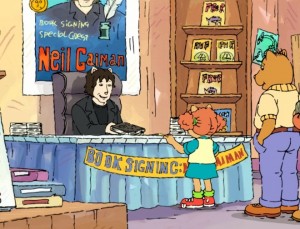I liked the feel of the eight chapters in Preludes and Nocturnes even before I read that Norman Mailer called Neil Gaiman’s work “a comic strip for intellectuals.” Imagine my amazement when I realized Gaiman was the kind, precise voice challenged in the most controversial petition ever considered by the American Library Association. When asked to purge a children’s book of a prestigious award, common sense and appreciation for literature prevailed, and Gaiman’s 2009 John Newbury Medal-winning The Graveyard Book was allowed to keep its gold seal of approval. Now the author had my attention, admiration, and sympathy. After all he is considered a hero in the world of education.
This work is thick with classical references. Morpheus, the Greek god of dreams, alternately know as Dream, is captured and imprisoned in a plot twist of mistaken identity. Imprisoned in his crystal cell for 70 years, Dream first appears to be a space alien with a skull, spinal column, and yards of flowing royal blue fabric. Gradually we see that he is a thin, attractive young man with longish black hair and determined eyes. Yes, I’d say that is a good depiction of the Greek god of dreams.
Alluding to Greek mythology of the Fates, Gaiman introduces three women who appear as Hecate: maiden, mother, and crone. These characters are also prominent in the opening scene of “Macbeth” as the weird sisters; they are central to the actual play as well as to the supernatural element that is disturbingly able to bridge both worlds: “Fair is foul, and foul is fair” (1.1.11-12). Preludes’ Fates present as confusing a motif as does Macbeth’s sisters.
Again classical mythology is referenced when the King of Dreams finds himself in Hell. He had earlier carved the gates of Horn and Ivory. Dream tells us that “DREAMS that pass through the gates of IVORY are LIES…The OTHER admits the TRUTH” (65/11). This Odyssean imagery refers to Penelope’s dream in which false dreams pass through ivory gate and the true “ones that come to pass” enter through the gate of polished horn.
Avant garde poetry is the source for the Sandman’s prophetic line “and I have shown him fear” that references T.S. Eliot’s poem The Waste Land, Part I. THE BURIAL OF THE DEAD
I will show you something different from either
Your shadow at morning striding behind you
Or your shadow at evening rising to meet you;
I will show you fear in a handful of dust.
The origin of this fear in Preludes and Nocturnes combines with actual sand and relates to the method the King of Dreams uses to escape from imprisonment. As his guards dream of girl-filled beach volleyball vacations, The King reaches into their dreams, scoops up a handful of sand, and, at the crucial moment when the crystal cell is unlocked, blows a puff of sand onto the guards (39.5-7). They never knew what hit them and Dreams is released to show fear to the unjust and grant sleep to the just.
